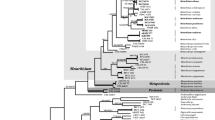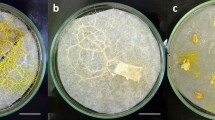Abstract
Tympanosporium parasiticum forms annellated conidiogenous cells with short cylindric (tympaniform) conidia in white sporodochia on Tubercularia vulgaris Tode ex Fr. On agar media the conidia form short necks and blow out narrow secondary conidia in a phialidic manner producing very restricted yeast-like colonies. Only in the vicinity of the host hyphae (without tropic growth or hyphal connections) mycelia develop which form phialidic or annellate conidiogenous cells with narrowly cylindrical conidia in the agar, and sporodochia with short truncate conidia like those on the natural substrate in the aerial mycelium. No other host fungus was found to support this kind of growth. The mode of parasitism is compared with that of other hyperparasitic fungi.
For Tympanosporium parasiticum the name Oospora candidula Sacc. was incorrectly used by Grove (1885) and the name Oospora filamentosa was proposed by Arnaud but never published.
Similar content being viewed by others
References
von Arx, J. A. 1972. Centraalbureau voor Schimmelcultures, Baarn and Delft; Progress Report 1971.— Verh. Kon. Ned. Akad. Wet., Afd. Natuurk., 2e Reeks, 61 (3): 50–69.
Barnett, H. L. 1964. Mycoparasitism.— Mycologia 56: 1–19.
Boosalis, M. G. 1964. Hyperparasitism.— Annu. Rev. Phytopathol. 2: 363–376.
Calderone, R. A. and Barnett, H. L. 1972. Axenic growth and nutrition of Gonatobotryum fuscum.— Mycologia 64: 153–160.
Gams, W. 1971. Cephalosporium-artige Schimmelpilze (Hyphomycetes).—G. Fischer, Stuttgart.
Grove, W. B. 1885. New or noteworthy fungi, part II.— J. Bot. 1885: 161–169.
Hennebert, G. L. 1968. Echinobotryum, Wardomyces and Mammaria— Trans. Brit. Mycol. Soc. 51: 749–762.
Morgan-Jones, G., Nag Raj, T. R. and Kendrick, B. 1972. Conidium ontogeny in Coelomycetes. IV. Percurrently proliferating phialides.— Can. J. Bot. 50: 2009–2014.
Morton, F. J. and Smith, G. 1963. The genera Scopulariopsis, Microascus, and Doratomyces. — Mycol. Pap. 86: 1–96.
Schol-Schwarz, M. B. 1968. Rhinocladiella, its synonym Fonsecaea and its relation to Phialophora.—Antonie van Leeuwenhoek 34: 119–152.
Author information
Authors and Affiliations
Rights and permissions
About this article
Cite this article
Gams, W. Tympanosporium parasiticum gen. et sp. nov., a hyperparasitic Hyphomycete on Tubercularia vulgaris with pleomorphic conidiogenesis. Antonie van Leeuwenhoek 40, 471–479 (1974). https://doi.org/10.1007/BF00399359
Received:
Issue Date:
DOI: https://doi.org/10.1007/BF00399359




